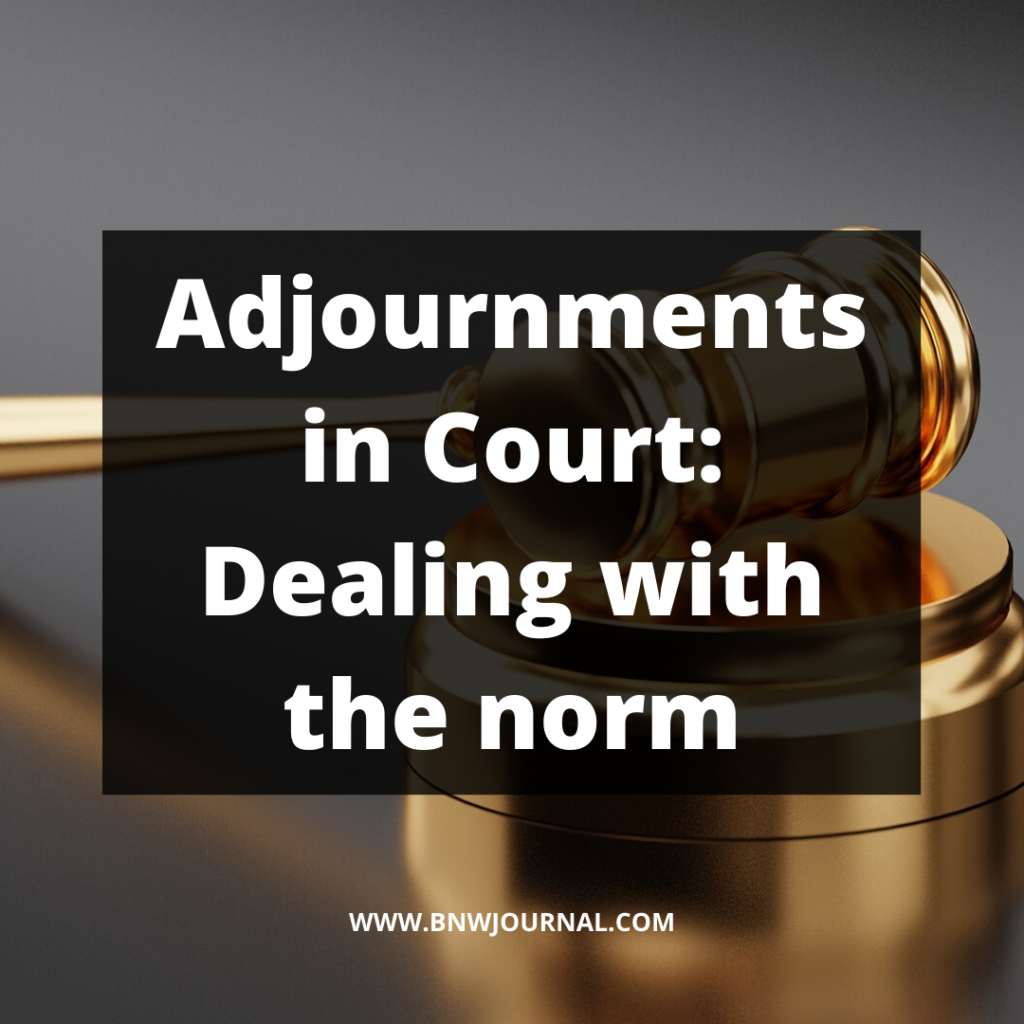![]()
Introduction
Adjournment is define as the postponement of the hearing of a case until some future date.[1] The intention of its introduction was to avoid hearing of cases in exceptional situations. It is to not act unfair to any of the parties. However, in the present times the adjournments are grant without giving any thought. They are use as a tool by lawyers to gather more evidence or to delay the proceedings of the court.

There is a backlog of 3.3 crore cases in various courts of the country. Of these, 2.84 crore cases are in the subordinate courts. Another 43 lakh are in the High Courts and about 58,000 in the Supreme Court[2] President Ram Nath Kovind said in the conference Supreme Court Advocates on Record Association that one of the reasons for long delays in the adjudication of cases in courts is the “culture of seeking Adjournments as a norm”.
The Allahabad High Court in the case of Siddhartha Kumar and others versus Upper Civil Judge[3] had asserted: “Adjournments are so lightly treated that for any reason on earth a case can be postponed/stifled to another date, which maybe after a few months.”
Legislations on Curbing the Practice of Adjournments
The Code Of Civil Procedure (Amendment) Bill, 1997substitutes sub–ru1e (1) of Ru1e 1 of Order XVII. It requires the court to record reasons in writing for every adjournment of the hearing of a suit. Furthermore, the proviso places a ceiling upon the number of adjournments which can be grant to a party during the hearing of the suit and is limit to three. [4] Order XVII does not forbid grant of adjournment where the circumstances are beyond the control of the party. In such a case, there is no restriction on the number of adjournments to be grant. This is following the vice of Article 14 of the Constitution of India. It does not take away the discretion from the court. As in some cases like the Covid-19 pandemic, or cases in the past such as the Bhopal Gas Tragedy, Gujarat riots, adjournments beyond three is allowed.
Slowly, the Supreme Court has also started denying various reasons commonly cited by lawyers for adjournment. In the case of Ram Siromani Tripathi & Ors. v. State of U.P & Ors.[5] It was held that counsel being out of station’ is not a ground for granting an adjournment. This is not consider a “sufficient cause” under Order 17.
To curb the practice of repeated adjournments in the cases. The Supreme Court has set a pre-condition to pay Rs 10,000 for the respondents. In this case it involves an 89-year old litigant that for every adjournment they may take in future. [6]
Suggestions that can help curb Adjournment practices
The law commission suggest that all the adjournments should not be made on oral requests. An application for the same should be file that should be sign by the counsel and support by the affidavit of the parties.
Further, measures should also take to award the total cost incurr by the other party on that days’ proceeding by the party asking for an adjournment.
The judges and lawyers should practice no Adjournment day- it entails full hearing in all the cases listed before the courts that day with neither the lawyers asking for adjournments, nor the Judges granting it, unless the facts and circumstances warrant otherwise.
The adjournment period of cases should be limit and not extend too far off dates. A maximum extension of 25-30 days should be grant except in special circumstances. If the parties continue with such action ex-parte rounds order should be given.
Technological interventions can also be made to ensure that cases are list before judges in a scientific manner and take into consideration certain parameters, such as the age of the case, the subject matter, the number of days between each hearing, and the timeline within which it has to be disposed of.[7] This analysis can help judges to ensure that matters are address timely and spot reasons as to why adjournments are given and try to curb them.
Conclusion
Former Chief Justice of India Justice JC Shah: “…..The accumulation has reached such a proportion that there is a danger of judicial administration breaking down in future years if the cases before the courts increase at the rate at which they are mounting today. “ He regrets that such input and output disparity in the number of cases, might take away the confidence of society in the judiciary. A sense of frustration might creep in the people.[8] The Allahabad High Court in its judgment had added that the disposal of cases pending in the courts cannot be speeded up by judicial officers only, without the essential cooperation of the members of the Bar.
References:
[1] Collins Dictionary of Law © W.J. Stewart, 2006
[2] https://economictimes.indiatimes.com/news/politics-and-nation/culture-of-adjournments-reason-of-long-delays-in-cases-president/articleshow/65635175.cms?utm_source=contentofinterest&utm_medium=text&utm_campaign=cppst
[3] Siddhartha Kumar and others versus Upper Civil Judge 1998 (1) AWC 593
[4] https://indiankanoon.org/docfragment/66462873/?formInput=adjournment%20granted.
[5] Ram Siromani Tripathi & Ors. v. State of U.P & Ors.
[6] https://www.newindianexpress.com/nation/2018/jun/17/supreme-court-sets-condition-to-curb-repeated-adjournments-1829191.html.
[7] https://www.livemint.com/Opinion/SOLU1HOQAfeWdoTsDRpolM/Opinion–Technology-for-better-case-management.html
[8] https://www.tribuneindia.com/news/archive/chandigarh/lawyers-need-to-observe-no-adjournment-days-859133.



0 Comments